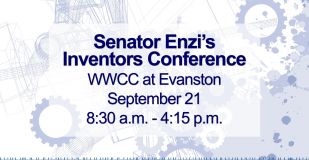Do you have an innovation that warrants funding from the federal government? Companies competing for Small Business Innovation Research (SBIR) and Small Business Technology Transfer (STTR) funds often propose too much work during the initial feasibility study. Reviewers are quick to point out this mistake which can move your proposal into the “Do Not Fund” pile. Luckily, the Wyoming SBIR/STTR Initiative—part of the Wyoming Small Business Development Center (SBDC) Network—is available to help residents in the state keep their proposal in the funding pile.
The first step is to size up the project from the outset to determine the appropriate amount of work that will be required by you. Let’s take a look at a quick and simple way to size your project so you can start developing your technical and cost proposals.
First, start by finding out the funding amount at the government agency you are applying to. Each agency is different in the amount they offer during the initial funding round called the Phase I. For example:
- U.S. Department of Agriculture – $100,000
- National Science Foundation – $150,000
- National Institute of Health – $225,000
Naturally, you can accomplish more research with a larger budget, so those working on an NIH project can have more tasks in their Phase I work plan than the team working on Phase I at USDA.
Not all of the SBIR funding is spent on direct research costs. As a small business, you are allowed to recoup some of your non-research costs.
All agencies allow the applicant to receive a Small Business Fee to use for unexpected (or sometimes otherwise prohibited) costs. We advise all of our clients to take full advantage of this small business fee since this will be the only money from the Phase I funding you can choose how to spend. We recommend you propose a 7% small business fee.
You will also want to account for funds to cover indirect costs such as rent, utilities, accounting, legal, telephone, internet, office supplies and administrative salary and benefits. Most startup companies use a simple, single rate system, although rates will vary from business to business. If you need assistance calculating your indirect rate, talk to the tech team at the Wyoming SBDC Network.
The amount you are left with is your direct cost for research and development. Typical direct costs on an SBIR or STTR project include direct labor of researchers, research materials, subcontractors and travel.
Let’s look at an example of this breakdown, but please note, the calculated numbers will not be your final budget numbers, they will instead be used to figure out how many research tasks to include in the initial project. Let’s assume you are applying to the USDA, so your starting point is $100,000. Let’s also assume a 40% indirect rate:
- Small Business Fee: Subtracting 7% from the initial amount, you will be left with $93,000
- Indirect Rate: This rate is calculated after the Small Business Fee. So, 40% of $93,000 is $37,200
- Direct Rate: $55,800 remains for the direct cost of your research and development.
So in this example, instead of scoping your research proposal for $100,000 worth of direct labor and direct supplies, you need to scale the project back to around $60,000 with fewer research tasks as part of the Phase I work plan. Remember this is a starting point, and you should do this before you begin designing your research study. This simple way to size your project will help you start off building a reasonable Phase I work plan and avoid the reviewers rejecting your project for proposing too much work.
If you are ready to start sizing up your research study, the WSSI and Wyoming SBDC Network are here to help. For more information, contact Kelly Haigler Cornish at haigler@uwyo.edu or (307) 766-2904.
ABOUT THE AUTHOR: Kelly Haigler Cornish is the Program Manager for the Wyoming SBIR/STTR Initiative, she has a bachelor degree in business administration and a master’s in public administration from the University of Wyoming. She has experience in technology transfer, intellectual property, data rights, indirect cost calculations, federal SBIR and STTR grants and contracts and other small business topics related to innovation and research. Kelly loves working with existing small businesses to help them discover their innovative edge and working with startups that are taking the next big thing to market.
When she’s not in the office:
Kelly enjoys baking, swimming, and reading
ABOUT THE WYOMING SBDC NETWORK: The Wyoming Small Business Development Center Network (SBDC) is a partnership between the University of Wyoming, the Wyoming Business Council and the U.S. Small Business Administration. The SBDC offers an enormous amount of business expertise to help Wyoming residents think about, launch, grow, reinvent or exit their business.






